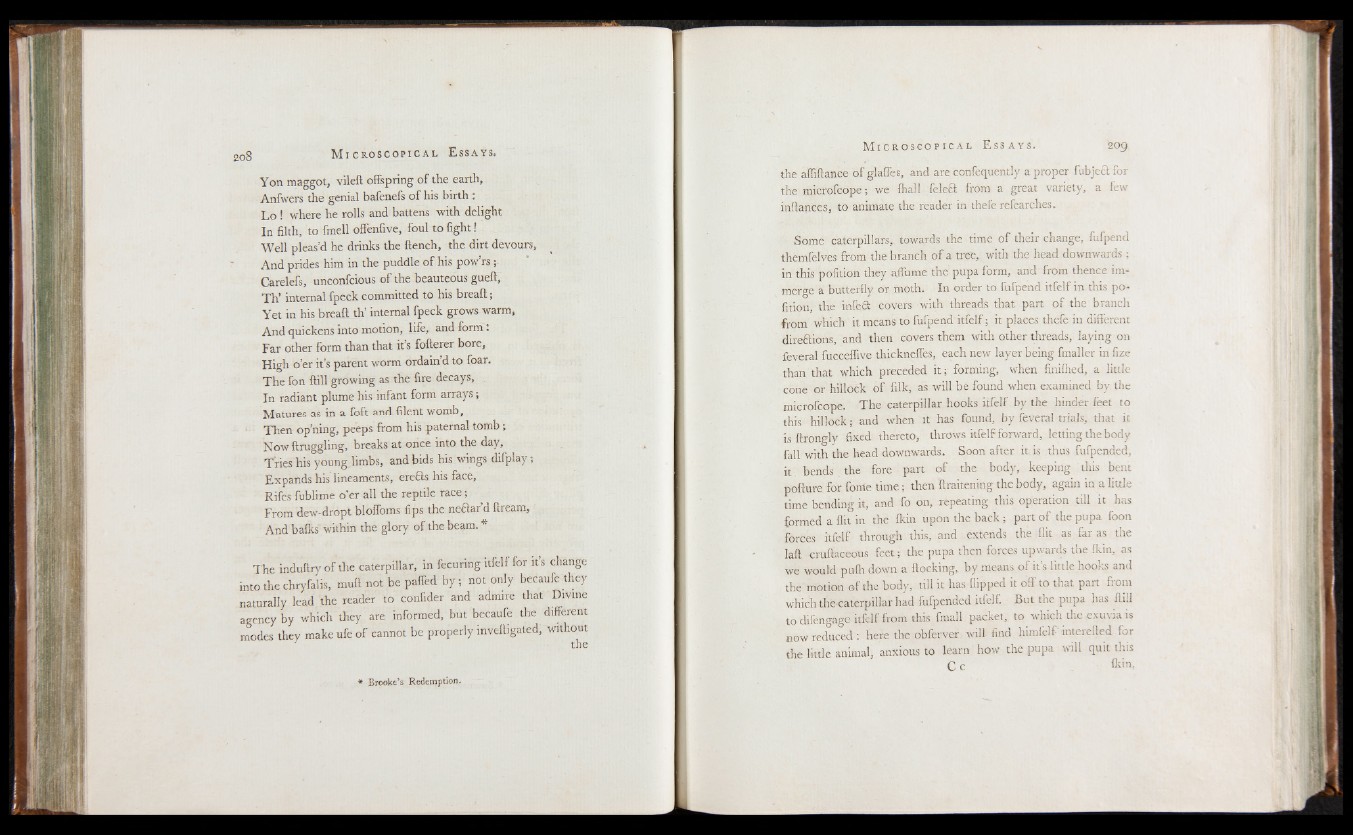
Yon maggot, vileft offspring o f the earth,
Anfwers the genial bafenefs of his birth :
Lo ! where he rolls and battens with delight
In filth, to fmell offenfive, foul to fight!
Well pleas’d he drinks the flench, the dirt devours,
And prides him in the puddle o f his pow’rs ;•
Carelefs, unconfcious of the beauteous gueft,
T h ’ internal fpeck committed to his breaft;
Yet in his breaft th’ internal fpeck grows warm,
And quickens into motion, life, and form:
Far other form than that its fofterer bore,
High o’er it’s parent worm ordain’d to foar.
The fon ftill growing as the fire decays,
In radiant plume his infant form arrays;
Matures as in a foft and filent womb,
Then op’ning, peeps from his paternal tomb ;
Now ftruggling, breaks at once into the day,
Tries his young limbs, and bids his wings difplay;
Expands his lineaments, erefts his face,
Rifes fublime o’er all the reptile race;
From dew-dropt bloifoms lips the neclar’d ftream,
And balks within the glory of the beam. *
The induftry o f the caterpillar, in fecuring itfelf for it’s change
into the chryfalis, muft not be paffed b y ; not only becaufe they
naturally lead the reader to confider and admire that Divine
agency by which they are informed, but becaufe the different
modes they make ufe of cannot be properly inveftigated; without
J the
* Brooke’s Redemption.
the affiftance o f glaffes, and are confequently a proper fubject for
the microfcope; we fhall felecl from a great variety, a few
inftances, to animate the reader in thefe refearches.
Some caterpillars, towards the time of their change, fufpend
themfelves from the branch o f a tree, with the head downwards ;
in this pofition they affume the pupa form, and from thence im-
merge a butterfly or moth. In order to fufpend itfelf in this pofition,
the infea covers with threads that part o f the branch
from which it means to fufpend itfelf; it places thefe in different
directions, and then covers them with other threads, laying on
feveral fucceflive thickneffes, each new layer being fmaller in fize
than that which preceded it; forming, when finifhed, a little
cone or hillock o f filk, as will be found when examined by the
microfcope. The caterpillar hooks itfelf by the hinder feet to
this hillock; and when it has found, by feveral trials, that it
is ftrongly fixed thereto, throws itfelf forward, letting the body
fall with the head downwards. Soon after it is thus fufpended,
it bends the fore part o f the body, keeping this bent
pofture for fonie time; then ftraitening the body, again in a little
time bending it, and fo on, repeating this operation till it has
formed a flit in the fkin upon the back ; part of the pupa foon
forces itfelf through this, and extends the flit as far as die
Iaft cruftaceous feet; the pupa then forces upwards the fkin, as
we would pufli down a flocking, by means o f it’s little hooks and
the motion of the body, till it has flipped it off to that part fiom
which the caterpillar had fufpended itfelf. But the pupa has ftill
to difengage itfelf from this fmall packet, to which the exuvia is
now reduced : here the obferver will find liimfelf interefted for
the little animal, anxious to learn how the pupa will quit this